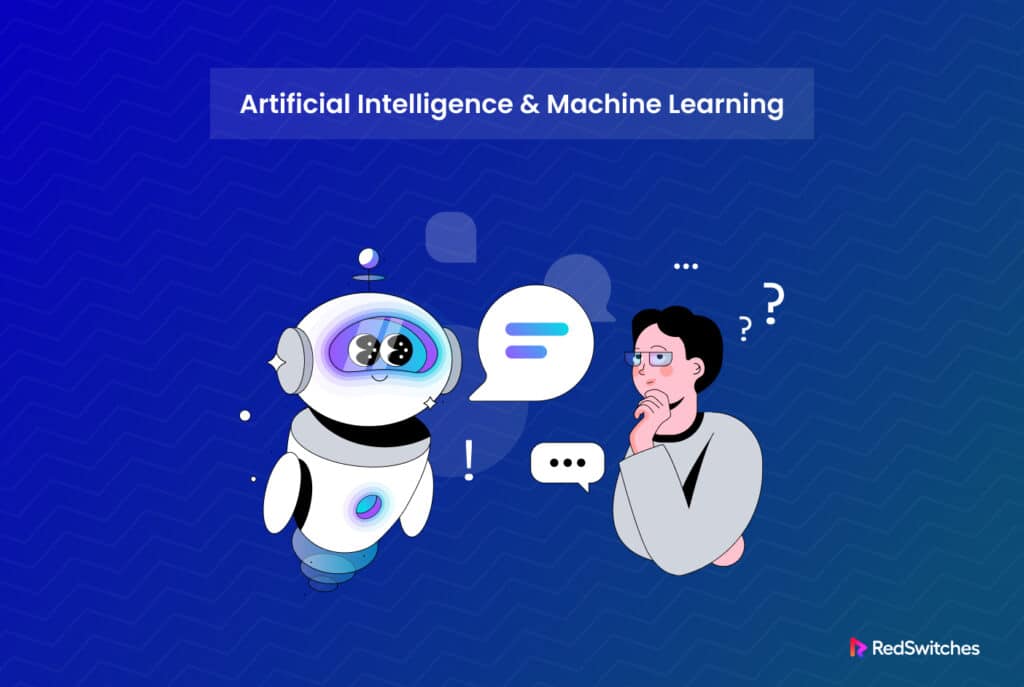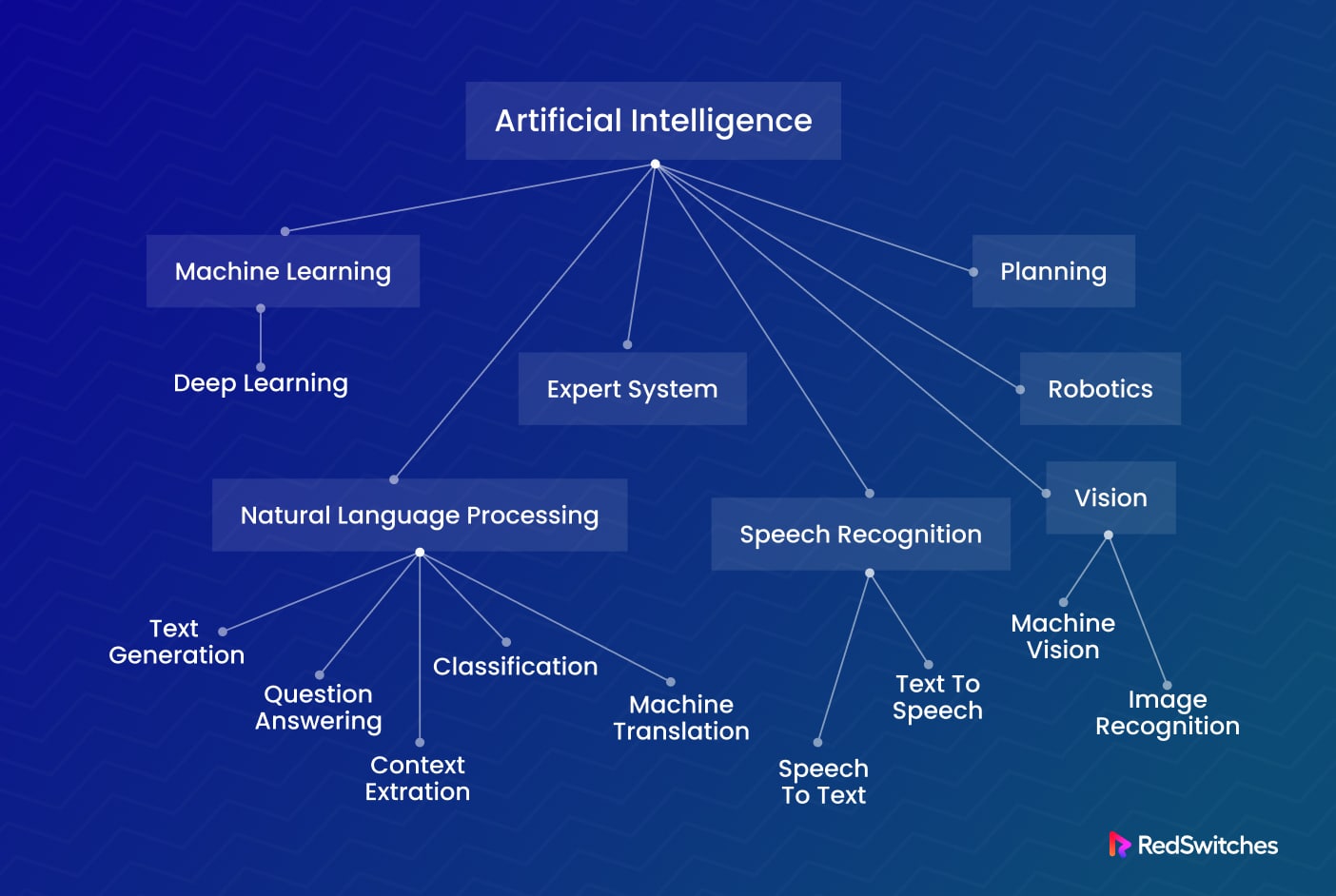Have you ever been curious about the inner workings behind your phone’s ability to instantly recognize your face or how Amazon seems to have an uncanny knack for recommending the perfect products?
The answer lies in the power of artificial intelligence and machine learning.
AI and ML are transformative technologies revolutionizing various industries and reshaping how we live, work, and interact. These technologies power self-driving cars, virtual assistants, personalized recommendations, and advanced data analytics.
Artificial intelligence and machine learning have become integral parts of our daily lives, often without us even realizing their critical importance for the rapidly evolving digital landscape.
This blog post will concisely introduce the fascinating world of AI and ML. We will explore these technologies’ fundamental concepts, applications, and implications. We’ll touch upon their significant impact on diverse sectors such as healthcare, finance, e-commerce, and more.
So, let’s dive in and uncover the key elements that make AI and ML so powerful and promising.
Table of content
- Understanding Artificial Intelligence
- Unveiling Machine Learning
- The Relationship Between Artificial Intelligence and Machine Learning
- Applications of Artificial Intelligence and Machine Learning
- Benefits of Using Artificial Intelligence and Machine Learning Together
- The Future of Artificial Intelligence and Machine Learning
- Conclusion
- FAQs
Understanding Artificial Intelligence
AI is a rapidly advancing field that aims to create intelligent systems that can perform tasks that require human-like intelligence.
These systems are designed to emulate human thought processes, enabling them to perform complex tasks such as data analysis, decision-making, and language interpretation. AI-powered programs can reason, learn, and act to solve intricate problems beyond traditional automated machines’ capabilities.
Machine Learning is a fundamental pillar of Artificial Intelligence (AI), and we will delve into its intricacies shortly.
Nonetheless, AI encompasses various subfields that go beyond Machine Learning. These include Deep Learning, Natural Language Processing (NLP), and Robotics.
Deep Learning involves leveraging artificial neural networks to perform intricate reasoning tasks autonomously, without human intervention. NLP focuses on creating software capable of interpreting human communication, while Robotics aims to create intelligent machines capable of learning and performing tasks in real-world environments.
Unveiling Machine Learning
Machine Learning, a subset of AI, is an influential technology that empowers machines and systems to learn and enhance their performance through experience without explicit programming-based decisions.
Instead of relying on predetermined instructions, machine learning algorithms are trained on large datasets, allowing them to identify patterns and make informed decisions. The more data they “ingest”, the better they become at executing specific tasks.
This process, known as data-driven learning, allows the algorithms to extract patterns, insights, and correlations from the data, enhancing their accuracy and proficiency over time.
The abundant availability of data fuels the advancement and refinement of these algorithms, leading to more robust and effective AI systems.
Machine Learning models, the output of the training process, can perform various tasks such as image recognition, sales forecasting, and big data analysis.
Models learn and evolve over time. They adapt to new information and improve their performance.
Machine Learning is a crucial driver of AI advancements and is widely used in various industries to automate processes, generate insights, and make data-driven decisions.
ML algorithms are used in many fields, such as image and speech recognition, natural language processing, recommendation systems, fraud detection, and autonomous vehicles.
The Relationship Between Artificial Intelligence and Machine Learning
While AI and ML are distinct concepts, they are closely interconnected.
AI serves as the broader concept, encompassing a range of technologies and approaches aimed at creating human-like cognition in machines. Machine Learning is a method in AI that helps machines learn from data and enhance their performance. It allows machines to identify patterns, predict outcomes, and adjust their actions based on the data they receive.
A helpful analogy is to think of AI as an umbrella term that covers various subfields, including Machine Learning. Under this umbrella, we find other subfields, such as Deep Learning, Robotics, and NLP. Machine Learning is just one of the tools used to achieve AI goals, along with other techniques and algorithms. Hence, while AI and ML are related, they are not synonymous, with ML being a subset of AI.
Applications of Artificial Intelligence and Machine Learning
AI and ML have many applications that can significantly influence the current and future processes in almost all industries.
By automating manual processes, analyzing large datasets, and generating actionable insights, AI and ML offer numerous benefits to organizations and businesses of all sizes.
Let’s explore some of the key industries where AI and ML are making a significant impact:
Healthcare
The healthcare industry has abundant data, making it an ideal field for AI and ML applications. With the help of Machine Learning models, medical records can be analyzed, diagnostic images can be interpreted, and personalized treatment plans can be developed without requiring significant human intervention.
These models can also help allocate hospital resources efficiently, better predict patient outcomes, and improve healthcare delivery and patient care.
Manufacturing
Manufacturing is among the first industries to benefit from AI and ML technologies.
These technologies optimize production processes and improve efficiency while reducing costs. Machine Learning algorithms can monitor production machines, detect errors before malfunctions occur, and perform predictive maintenance. By analyzing energy consumption patterns, AI systems can optimize HVAC systems, leading to significant energy savings.
Banking and Finance
In banking and finance, data privacy and security are absolute requirements. AI and ML are crucial for preventing fraud and cybersecurity attacks.
Machine Learning models can analyze financial data in real time and detect suspicious patterns. Companies are utilizing AI-powered chatbots and voice assistants to automate customer service. These tools are also capable of providing personalized experiences for customers.
Retail and E-commerce
Artificial Intelligence and Machine Learning have transformed retail and e-commerce.
ML models analyze customer behavior, preferences, and purchase history. For the customers, these translate into personalized product recommendations and offers. Visual search technology enhances the shopping experience by allowing customers to find products that match user-supplied images.
AI-powered demand forecasting and inventory optimization systems help retailers manage their supply chains more efficiently, reducing costs and improving customer satisfaction.
Telecommunications
In telecommunications, AI and ML optimize network performance, predict maintenance needs, and automate business processes.
Machine Learning models can analyze network data, detect anomalies, and predict network congestion or failures. This proactive approach helps telecommunication companies ensure uninterrupted service and plan network upgrades more effectively.
Transportation and Autonomous Vehicles
AI and ML technologies are driving advancements in the transportation sector. Autonomous vehicles rely on data models and decision-making capabilities to perceive their surroundings and make real-time safe navigation decisions. AI-based algorithms optimize traffic flow, reduce congestion, and improve logistics and route planning.
Natural Language Processing (NLP)
NLP teaches machines to understand and interact with human language. Siri and Alexa use NLP to answer questions and perform tasks. It’s also used for sentiment analysis, language translation, and chatbot interactions.
Cybersecurity
Artificial Intelligence and Machine Learning are used in cybersecurity to detect and respond to cyber threats.
ML algorithms identify malicious patterns, detect anomalies, and prevent attacks. AI systems continuously learn and adapt to evolving threats, providing proactive defense mechanisms.
AI and ML are changing industries in big ways. They’re transforming healthcare and making manufacturing more efficient. The possibilities for AI and ML are endless and constantly growing.
Benefits of Using Artificial Intelligence and Machine Learning Together
AI and ML provide advantages to organizations in different sectors. Businesses can benefit from the advantages of AI and ML. Let’s take a look at some of these benefits.
Deeper Data Analysis
Organizations can analyze and activate more data sources with AI and ML. These technologies help businesses gain insights from large datasets that were hard to process manually. Businesses can engage structured and unstructured data sources to extract valuable insights from multiple channels.
Faster Decision Making
ML algorithms result in faster data processing, improved data integrity, and reduced human error. This means quicker and better-informed decisions based on processing a huge dataset. AI and ML can automate repetitive tasks and provide real-time insights, helping businesses respond promptly to market changes.
Increased Efficiency
AI and ML can improve operational efficiency and cut costs by automating manual tasks. These technologies can simplify workflows, allocate resources more effectively, and eliminate repetitive duties. This frees up employees to concentrate on more strategic and valuable activities.
Improved Customer Experiences
Businesses can use Artificial Intelligence and Machine Learning to provide personalized experiences to customers. Organizations can tailor their products, services, and marketing efforts by analyzing customer data, preferences, and behavior to meet individual needs and tastes. AI-powered chatbots and virtual assistants offer instant and personalized customer support, improving customer satisfaction and loyalty.
The Future of Artificial Intelligence and Machine Learning
The global market for AI and ML is projected to grow significantly in the coming years. As more organizations recognize the value of these technologies, investments in AI and ML are expected to increase.
Businesses that adopt AI and ML early on will gain a competitive advantage, leveraging the power of data-driven insights to drive innovation and growth.
Advancements in deep learning, explainable AI, and ethical considerations will drive the development of more robust and transparent AI systems.
Emerging technologies like IoT, AR, and VR can offer immersive and intelligent experiences.
In the not-so-distant future, people collaborating with AI systems will become more common, boosting human abilities and trust. The future of AI and ML holds great promise for innovation, efficiency, and positive societal impact.
Conclusion
AI and Machine Learning are changing industries and how organizations operate and make decisions.
Artificial Intelligence provides the overarching concept of creating human-like cognition in machines, while Machine Learning serves as a specific method within the AI field.
As these technologies continue to evolve, the need for robust and reliable infrastructure becomes increasingly crucial. That’s why RedSwitches offer a range of customizable bare-metal servers that you can further upgrade to accommodate the demands of computation-intensive AI and ML projects.
Contact our support engineers today for a free consultation about building your bare-metal infrastructure for AI and ML projects.
FAQs
Q: How do AI and ML differ from traditional programming?
A: Traditional programming involves explicitly instructing a computer on how to perform a task. In contrast, AI and ML systems learn from data and experience, allowing them to adapt and improve their performance over time without explicit programming for every scenario.
Q: What are the different types of machine learning?
A: Three main machine learning types are supervised, unsupervised, and reinforcement. Supervised learning involves training a model on labeled data, unsupervised learning focuses on finding patterns in unlabeled data, and reinforcement learning involves training a model through interactions with an environment to maximize rewards.
Q: What are neural networks?
A: Neural networks are computational models inspired by the structure and functioning of the human brain. They consist of interconnected nodes (neurons) organized in layers. Neural networks are widely used in deep learning, a subfield of machine learning, to solve complex problems such as image and speech recognition.
Q: What is the role of data in AI and ML?
A: Data plays a crucial role in AI and ML. Models are trained on large datasets to learn patterns and make predictions. The quality, quantity, and diversity of data directly impact the performance and accuracy of AI and ML systems. Data preprocessing, cleaning, and selection are vital steps in the machine learning pipeline.
Q: Can AI and ML replace human jobs?
A: AI and ML have the potential to automate specific tasks and job functions, but they are more likely to augment human capabilities rather than entirely replace jobs. These technologies are better suited to handle repetitive, data-driven tasks, allowing humans to focus on higher-level decision-making, creativity, and problem-solving.


